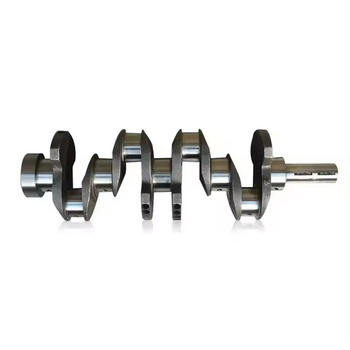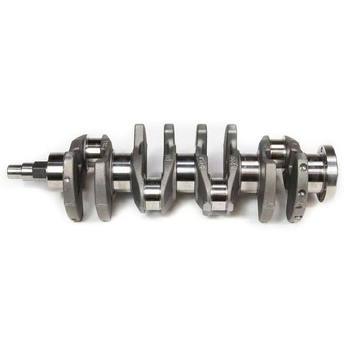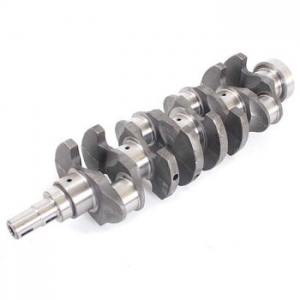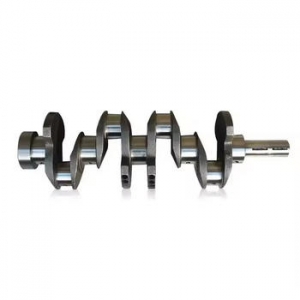Forged vs. Billet Crankshafts: A Deep Dive into Industrial Applications and Performance
When it comes to the heart of any reciprocating engine or compressor, the crankshaft stands as a pivotal component, converting linear piston motion into rotational energy. Its integrity and performance are absolutely critical, especially in demanding industrial applications where reliability and longevity are paramount. Frankly speaking, the choice between a forged crankshaft and a billet crankshaft isn’t just a matter of preference; it’s a strategic decision that impacts everything from manufacturing cost and lead time to the ultimate performance and durability of heavy machinery. Have you ever wondered what truly separates these two manufacturing marvels and why one might be chosen over the other in a specific industrial setting?
This article aims to provide a comprehensive comparison, dissecting the unique characteristics, manufacturing processes, and ideal scenarios for both forged and billet crankshafts within the industrial landscape. We'll delve into the nuances that dictate their suitability for various heavy-duty tasks, offering insights into the complex world of engine component engineering. Understanding the distinct advantages and disadvantages of each is crucial for engineers, procurement specialists, and anyone involved in the design, maintenance, or operation of industrial equipment. Let's explore the fundamental differences that define the performance of a forged crankshaft vs billet industrial applications.
Understanding Forged Crankshafts: The Workhorse of Industry
Forged crankshafts have long been the backbone of countless industrial engines, from massive marine diesels to robust power generation units and heavy construction equipment. Their prevalence isn't accidental; it's a testament to a manufacturing process that inherently imbues the material with superior strength and fatigue resistance.
The Forging Process: Strength Through Grain Flow
The creation of a forged crankshaft begins with a solid piece of steel, often an alloy like 4340 or 300M, which is heated to a malleable temperature. This heated material is then subjected to immense pressure, typically through a series of hammering or pressing operations. This process, known as forging, forces the metal to flow into the desired shape. The key advantage here lies in the creation of a continuous grain flow within the material, which follows the contours of the crankshaft.
Imagine the metal's internal structure as a series of fibers. In a forged part, these fibers are aligned with the shape of the component, making it incredibly strong along the lines of stress. This uninterrupted grain flow is what gives forged crankshafts their exceptional resistance to fatigue and impact loads. It's worth noting that this structural integrity is difficult, if not impossible, to achieve with other manufacturing methods.
After the initial forging, the crankshaft undergoes several subsequent processes, including heat treatment to achieve the desired hardness and toughness, and then precision machining to meet the exact dimensional specifications. This multi-stage process is well-established and highly refined, contributing to the consistent quality of forged components.
Advantages of Forged Crankshafts in Industrial Use
- Superior Strength-to-Weight Ratio: Due to the aligned grain structure, forged crankshafts can often achieve high strength with less material, potentially leading to lighter components without sacrificing durability.
- Excellent Fatigue Resistance: The continuous grain flow significantly reduces the likelihood of crack initiation and propagation, making them ideal for applications subjected to continuous, cyclical loading. In my experience, this is a critical factor for long-term reliability in industrial settings.
- Cost-Effectiveness for High Volume: While the initial tooling costs for forging dies can be substantial, the per-unit cost becomes very competitive in high-volume production runs. This makes them economically viable for mass-produced industrial engines.
- Proven Reliability: Forging is a mature technology with decades of proven performance in the most demanding environments. Many experts agree that for sheer robustness and predictable performance, forged parts are hard to beat.
Typical Industrial Applications for Forged Crankshafts
Forged crankshafts are the go-to choice for applications where durability, reliability, and cost-effectiveness in large volumes are paramount. This includes:
- Heavy-Duty Diesel Engines: Found in trucks, buses, marine vessels, locomotives, and large construction equipment (e.g., excavators, bulldozers).
- Power Generation: Crankshafts for generator sets, especially those used for continuous power supply.
- Industrial Compressors: Reciprocating compressors for gas and air, where continuous operation and high pressures are common.
- Agricultural Machinery: Tractors and other farm equipment that operate under strenuous conditions for extended periods.

Exploring Billet Crankshafts: Precision and Customization
In contrast to forged crankshafts, billet crankshafts represent the pinnacle of precision machining and material utilization. While historically more common in high-performance racing engines, their advantages in specific industrial niches are becoming increasingly recognized, particularly where custom designs, rapid prototyping, or extreme performance requirements outweigh volume production economics.
The Billet Manufacturing Process: Machined from Solid
A billet crankshaft starts as a solid block (or "billet") of high-grade steel, often similar alloys to those used in forging, but sometimes even more exotic materials. Instead of being hammered or pressed into shape, the entire crankshaft is precisely machined from this solid block using advanced Computer Numerical Control (CNC) milling machines.
This "subtractive" manufacturing process involves removing material layer by layer until the final, intricate shape of the crankshaft is achieved. While it offers unparalleled precision and design flexibility, it also means that the internal grain structure of the original billet is simply cut through, rather than being aligned with the component's contours as in forging.
Post-machining, billet crankshafts also undergo heat treatment, grinding, and polishing to achieve their final specifications and surface finish. The entire process is highly automated and allows for extremely tight tolerances.
Advantages of Billet Crankshafts in Industrial Use
- Unmatched Design Flexibility: Because they are machined from a solid block, billet crankshafts can be designed with virtually any geometry. This is invaluable for custom engine builds, experimental designs, or applications requiring unique stroke, counterweight, or journal configurations.
- Rapid Prototyping and Short Lead Times: Without the need for expensive and time-consuming forging dies, billet crankshafts can be designed, manufactured, and iterated much faster. This is a significant advantage for R&D projects or urgent replacement parts.
- Superior Material Purity: While not a direct result of the machining process itself, billet materials are often chosen for their exceptional purity and consistency, which can contribute to overall strength and reliability.
- Precision and Balance: CNC machining allows for extremely tight tolerances and precise balancing, which can lead to smoother operation and reduced vibration, a benefit in sensitive industrial machinery.
Typical Industrial Applications for Billet Crankshafts
While less common than forged crankshafts for mass production, billet crankshafts find their niche in specialized industrial applications:
- High-Performance Industrial Engines: Where maximum power output, specific weight reduction, or unique operating parameters are required, such as in specialized aerospace ground support equipment or high-speed industrial pumps.
- Prototype Development: For engine manufacturers developing new industrial engine platforms, billet crankshafts allow for rapid testing and design iterations without the upfront cost of forging dies.
- Low-Volume, Custom Machinery: For bespoke industrial machines or one-off projects where standard forged components don't meet specific requirements.
- Critical Replacement Parts: In situations where a highly specialized crankshaft is needed quickly for an older or custom piece of equipment, and forging dies are no longer available or economically viable for a single unit.

Forged Crankshaft vs Billet Industrial Applications: A Direct Comparison
The core of the debate surrounding forged crankshaft vs billet industrial applications boils down to a few critical factors: strength, cost, lead time, and application suitability. Understanding these trade-offs is key to making an informed decision.
Strength and Durability: A Nuanced Perspective
It's a common misconception that billet crankshafts are inherently "stronger" than forged ones. To be honest, this isn't entirely accurate. While billet crankshafts are often made from high-grade materials, the manufacturing process itself doesn't confer the same grain flow advantages as forging. A properly designed and manufactured forged crankshaft, with its continuous grain flow, often exhibits superior fatigue resistance and impact strength for a given material and weight.
However, billet crankshafts can compensate for this by using higher strength alloys or by being designed with more material in critical areas, effectively over-engineering them for the task. For extreme, low-volume applications where ultimate strength is needed regardless of cost, a custom billet design can indeed be superior. But for the vast majority of heavy-duty industrial applications, the inherent structural integrity of a forged part makes it the more reliable and cost-effective choice for long-term endurance.
Cost and Production Volume
This is perhaps the most significant differentiator. Forging requires substantial upfront investment in dies and tooling, but once these are made, the per-unit cost drops dramatically with volume. This makes forged crankshafts highly economical for mass production.
Billet machining, on the other hand, has minimal tooling costs, but the machining time per unit is significantly longer, and material waste is higher. This results in a much higher per-unit cost, making billet crankshafts economically viable only for low-volume, custom, or prototype applications. For large-scale industrial engine manufacturing, the cost of billet crankshafts would be prohibitive.
Lead Time and Flexibility
Billet crankshafts win hands down in terms of lead time and design flexibility. A new design can be programmed into a CNC machine and produced within weeks, sometimes even days, assuming material availability. Changes to the design are also relatively easy to implement.
Forging, conversely, involves a much longer lead time. Designing and manufacturing forging dies can take months, and any design changes necessitate costly and time-consuming die modifications. This makes forging less suitable for rapid prototyping or highly customized, one-off solutions.
Application Suitability: Matching the Right Crankshaft to the Job
In essence, the choice boils down to the specific demands of the industrial application:
- Forged Crankshafts: Best for high-volume production of standard industrial engines and machinery where long-term reliability, fatigue resistance, and cost-effectiveness are paramount. Think of engines in commercial vehicles, power plants, and mining equipment.
- Billet Crankshafts: Ideal for specialized, low-volume, or custom industrial applications where unique design requirements, rapid prototyping, or extreme performance (often at a higher cost) are the primary drivers. This could include specialized test rigs, unique industrial pumps, or bespoke power units.
Real-World Industrial Applications of Forged and Billet Crankshafts
Let's consider some concrete examples to illustrate where each type of crankshaft truly shines in the industrial landscape.
Heavy-Duty Power Generation
Consider a large diesel generator set providing continuous power to a factory or a remote mining operation. These engines run for thousands of hours under consistent load, experiencing millions of stress cycles. For such an application, a forged crankshaft is almost universally preferred. Its inherent fatigue resistance and proven durability ensure the long operational life required, while the volume of production for these engines makes the forged option economically sensible. The cost of failure in such critical infrastructure is immense, making reliability the top priority, which forged components deliver consistently.
Specialized Oil & Gas Drilling Equipment
In the oil and gas industry, some drilling equipment might require highly specialized engines or pump systems that operate under unique pressures or in extreme environments. If a standard engine configuration isn't suitable, or if a new, experimental pump design is being tested, a billet crankshaft might be chosen. The ability to quickly iterate on designs, fine-tune counterweights for specific vibration characteristics, or create a crankshaft with non-standard journal sizes for custom bearings makes billet a valuable asset in R&D and niche, high-value applications. The lower volume of these specialized units also makes the higher per-unit cost of billet more acceptable.
Marine Propulsion Systems
Large marine engines, propelling cargo ships or naval vessels across oceans, are another prime example of forged crankshaft dominance. These engines are designed for decades of service, operating continuously for weeks or months at a time. The immense forces generated and the need for unwavering reliability mean that the fatigue strength of a forged crankshaft is indispensable. The sheer size of some of these crankshafts, weighing many tons, also makes forging the only practical and economical manufacturing method for such scale.
Custom Industrial Robotics or Test Rigs
Imagine a highly specialized industrial robot arm or a precision test rig designed for material fatigue testing. These might incorporate small, high-revving engines or actuators where specific power delivery or vibration control is critical, and the production volume is extremely low (perhaps just one or two units). In such cases, a billet crankshaft might be used because it allows for absolute precision in balancing, custom geometries to fit unique packaging constraints, and the ability to use exotic materials if needed for specific performance metrics. The higher cost is justified by the unique requirements and the absence of mass production.
Interestingly enough, while the debate of forged crankshaft vs billet industrial applications often centers on strength, it's the interplay of volume, cost, and design flexibility that truly defines their respective sweet spots.
The Future Landscape: Innovations and Material Science
The field of crankshaft manufacturing is not static. Advances in material science, such as new steel alloys with improved properties, and innovations in manufacturing processes, like additive manufacturing (3D printing) for complex prototypes, continue to push boundaries. While 3D printing isn't yet viable for full-scale industrial crankshafts, it's influencing tooling and prototyping.
Furthermore, improvements in forging techniques, such as precision forging, are reducing the amount of post-forging machining required, making them even more efficient. Simultaneously, advancements in CNC machining and cutting tool technology are making billet production faster and more cost-effective for increasingly larger components.
In my experience, the lines between what's exclusively "forged" and "billet" are blurring at the edges, particularly for mid-volume, high-performance industrial applications. However, for the foreseeable future, the fundamental principles of grain flow for forging and precision subtractive manufacturing for billet will continue to define their primary roles. The decision will always come down to a careful analysis of the specific industrial application's demands, balancing performance, cost, and lead time.
Ultimately, whether a forged crankshaft or a billet crankshaft is chosen for an industrial application, both represent incredible feats of engineering. The right choice ensures the longevity, efficiency, and reliability of the machinery that powers our world.
For more detailed information, please visit our official website:forged crankshaft
About the author: Dr. Alistair Finch is a veteran mechanical engineer with over 25 years of experience specializing in heavy machinery design and powertrain components. Holding a Ph.D. in Material Science, he has consulted for leading industrial manufacturers on crankshaft selection, engine optimization, and fatigue analysis. His practical insights into the performance of forged and billet components in real-world industrial applications are widely respected.
 Powering Giants: Unveiling the
Powering Giants: Unveiling the
 Unlocking Power: The Essential
Unlocking Power: The Essential
 Unlocking Power: A Deep Dive i
Unlocking Power: A Deep Dive i
 Forged vs. Billet Crankshafts:
Forged vs. Billet Crankshafts:
